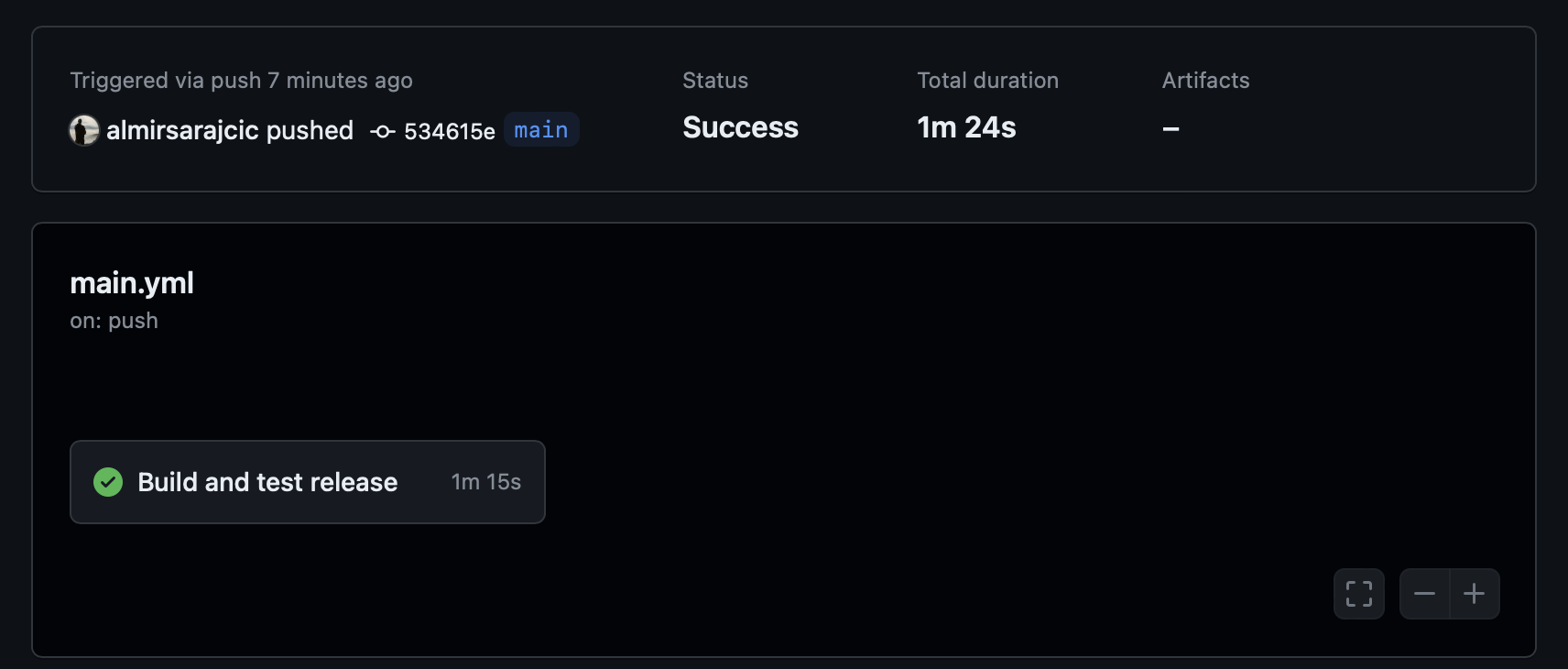Have you ever deployed your app and called it a day only to find out later that in production some NIF was missing or a 3rd party application wasn't started? No, that never happens to you because you always run your app locally with MIX_ENV=prod before deploying, right? Right?
Last year I worked on a project with a really conscientious team. We were working on an umbrella project consisting of 6 apps, and a colleague of mine always made sure to build a release for each of them in the prod environment and run it manually on his machine, then deploy it worry-free. It took some time to do that and it was a boring process, so to help him out, I automated the process by building a release and running it for each app in CI. Then, if everything passed, we'd proceed with the deployment.
At Optimum, we usually strive to deploy preview apps assuring us that the app is successfully built and running on a Fly.io server. Sometimes we have a different setup, for which we may build a release as part of our CI.
I'm going to show you how it works in a sample Phoenix app that will execute some code from ExUnit which will be missing in production. The code is available in the repo: https://github.com/almirsarajcic/testing_release.
Failing example
Let's generate a new Phoenix app that consists of only an API endpoint.
mix phx.new testing_release --adapter bandit --no-assets --no-ecto --no-esbuild --no-gettext --no-html --no-live --no-mailer --no-tailwind
Create a controller in a new file lib/testing_release_web/controllers/home_controller.ex:
defmodule TestingReleaseWeb.HomeController do
use TestingReleaseWeb, :controller
def index(conn, _params) do
ExUnit.__info__(:functions) |> IO.inspect(label: "ExUnit functions")
json(conn, %{status: "ok"})
end
end
Add the route:
scope "/api", TestingReleaseWeb do
pipe_through :api
get "/", HomeController, :index
end
You can see the full commit here: https://github.com/almirsarajcic/testing_release/commit/378f30c124ca7814e43b8685e57cf350caceb20d.
After setting that up, I can launch a Fly.io server:
fly launch --generate-name --vm-memory 256
After it's been deployed I can visit URL https://old-wave-7774.fly.dev/api and get the following response:
{"errors":{"detail":"Internal Server Error"}}
Executing fly logs shows:
[error] ** (UndefinedFunctionError) function ExUnit.__info__/1 is undefined (module ExUnit is not available)
ExUnit.__info__(:functions)
(testing_release 0.1.0) lib/testing_release_web/controllers/home_controller.ex:5: TestingReleaseWeb.HomeController.index/2
(testing_release 0.1.0) lib/testing_release_web/controllers/home_controller.ex:1: TestingReleaseWeb.HomeController.action/2
(testing_release 0.1.0) lib/testing_release_web/controllers/home_controller.ex:1: TestingReleaseWeb.HomeController.phoenix_controller_pipeline/2
(phoenix 1.7.12) lib/phoenix/router.ex:484: Phoenix.Router.__call__/5
(testing_release 0.1.0) lib/testing_release_web/endpoint.ex:1: TestingReleaseWeb.Endpoint.plug_builder_call/2
(testing_release 0.1.0) lib/testing_release_web/endpoint.ex:1: TestingReleaseWeb.Endpoint.call/2
(bandit 1.5.0) lib/bandit/pipeline.ex:124: Bandit.Pipeline.call_plug!/2
But we won't fix the error yet. Let's reproduce it in CI.
Automating release process
We can use the same Dockerfile generated for us while running fly launch to start a container in GitHub Actions and then send an HTTP request to verify it works as expected. We'll be using a script github_workflows_generator we introduced in the blog post Maintaining GitHub Actions workflows to write the workflow in Elixir.
Here we'll focus only on the steps of the workflow, but you can see the full commit on the following link: https://github.com/almirsarajcic/testing_release/commit/65def71031669cf7fcde77918f9b073e95bca4d3.
steps: [
[
name: "Checkout",
uses: "actions/checkout@v3"
],
[
name: "Set up Docker Buildx",
uses: "docker/setup-buildx-action@v1"
],
[
name: "Cache Docker layers",
uses: "actions/cache@v3",
with: [
path: "/tmp/.buildx-cache",
key: "${{ runner.os }}-buildx-${{ github.sha }}",
"restore-keys": "${{ runner.os }}-buildx"
]
],
[
name: "Build image",
uses: "docker/build-push-action@v2",
with: [
context: ".",
builder: "${{ steps.buildx.outputs.name }}",
tags: "testing_release:latest",
load: true,
"build-args": "target=testing_release",
"cache-from": "type=local,src=/tmp/.buildx-cache",
"cache-to": "type=local,dest=/tmp/.buildx-cache-new,mode=max"
]
],
[
# Temp fix
# https://github.com/docker/build-push-action/issues/252
# https://github.com/moby/buildkit/issues/1896
name: "Move cache",
run: "rm -rf /tmp/.buildx-cache\nmv /tmp/.buildx-cache-new /tmp/.buildx-cache"
],
[
name: "Create the container",
id: "create_container",
run:
"echo ::set-output name=container_id::$(docker create -p 4000:4000 -e FLY_APP_NAME=${{ env.FLY_APP_NAME }} -e FLY_PRIVATE_IP=${{ env.FLY_PRIVATE_IP }} -e PHX_HOST=${{ env.PHX_HOST }} -e SECRET_KEY_BASE=${{ env.SECRET_KEY_BASE }} testing_release | tail -1)"
],
[
name: "Start the container",
run: "docker start ${{ steps.create_container.outputs.container_id }}"
],
[
name: "Check HTTP status code",
uses: "nick-fields/retry@v2",
with: [
command:
"INPUT_SITES='[\"http://localhost:4000/api\"]' INPUT_EXPECTED='[200]' ./scripts/check_status_code.sh",
max_attempts: 3,
retry_wait_seconds: 5,
timeout_seconds: 1
]
],
[
name: "Write Docker logs to a file",
if: "failure() && steps.create_container.outcome == 'success'",
run:
"docker logs ${{ steps.create_container.outputs.container_id }} >> docker.log"
],
[
name: "Upload Docker log file",
if: "failure()",
uses: "actions/upload-artifact@v3",
with: [
name: "docker.log",
path: "docker.log"
]
]
]
Most of the steps are related to setting up Docker for caching intermediary images so that subsequent runs are quicker, but these steps are the most important:
[
name: "Start the container",
run: "docker start ${{ steps.create_container.outputs.container_id }}"
],
[
name: "Check HTTP status code",
uses: "nick-fields/retry@v2",
with: [
command:
"INPUT_SITES='[\"http://localhost:4000/api\"]' INPUT_EXPECTED='[200]' ./scripts/check_status_code.sh",
max_attempts: 3,
retry_wait_seconds: 5,
timeout_seconds: 1
]
]
After building the image and creating the container, we start it, and then send an HTTP request to it. We're not sure when the server is ready, so we use nick-fields/retry action to retry sending the request with a configurable number of maximum attempts. To send a request we use a convenient script scripts/check_status_code.sh I copied from https://github.com/lakuapik/gh-actions-http-status.
In the end, we upload a log as an artifact so we can inspect it in case the request fails.
There's an additional change we have to make to enable running the release outside of Fly.io environment. In the file rel/env.sh.eex replace the line
export ERL_AFLAGS="-proto_dist inet6_tcp"
with
if [[ -z "${FLY_PRIVATE_IP}" ]]; then
export ERL_AFLAGS="-proto_dist inet6_tcp"
fi
After pushing the code to GitHub, you can see requests failing.

Checking the log file saved as an artifact

shows the following error messages:
15:31:02.527 [info] Running TestingReleaseWeb.Endpoint with Bandit 1.5.0 at :::4000 (http)
15:31:02.528 [info] Access TestingReleaseWeb.Endpoint at https://localhost
15:31:07.848 request_id=F8rJ9kxkVangNu4AAAAE [info] GET /api
15:31:07.848 request_id=F8rJ9kxkVangNu4AAAAE [info] Sent 500 in 251µs
15:31:07.849 request_id=F8rJ9kxkVangNu4AAAAE [error] ** (UndefinedFunctionError) function ExUnit.__info__/1 is undefined (module ExUnit is not available)
ExUnit.__info__(:functions)
(testing_release 0.1.0) lib/testing_release_web/controllers/home_controller.ex:5: TestingReleaseWeb.HomeController.index/2
(testing_release 0.1.0) lib/testing_release_web/controllers/home_controller.ex:1: TestingReleaseWeb.HomeController.action/2
(testing_release 0.1.0) lib/testing_release_web/controllers/home_controller.ex:1: TestingReleaseWeb.HomeController.phoenix_controller_pipeline/2
(phoenix 1.7.12) lib/phoenix/router.ex:484: Phoenix.Router.__call__/5
(testing_release 0.1.0) lib/testing_release_web/endpoint.ex:1: TestingReleaseWeb.Endpoint.plug_builder_call/2
(testing_release 0.1.0) lib/testing_release_web/endpoint.ex:1: TestingReleaseWeb.Endpoint.call/2
(bandit 1.5.0) lib/bandit/pipeline.ex:124: Bandit.Pipeline.call_plug!/2
15:31:13.856 request_id=F8rJ97J1J9nc0xoAAAAB [info] GET /api
15:31:13.856 request_id=F8rJ97J1J9nc0xoAAAAB [info] Sent 500 in 243µs
15:31:13.856 request_id=F8rJ97J1J9nc0xoAAAAB [error] ** (UndefinedFunctionError) function ExUnit.__info__/1 is undefined (module ExUnit is not available)
ExUnit.__info__(:functions)
(testing_release 0.1.0) lib/testing_release_web/controllers/home_controller.ex:5: TestingReleaseWeb.HomeController.index/2
(testing_release 0.1.0) lib/testing_release_web/controllers/home_controller.ex:1: TestingReleaseWeb.HomeController.action/2
(testing_release 0.1.0) lib/testing_release_web/controllers/home_controller.ex:1: TestingReleaseWeb.HomeController.phoenix_controller_pipeline/2
(phoenix 1.7.12) lib/phoenix/router.ex:484: Phoenix.Router.__call__/5
(testing_release 0.1.0) lib/testing_release_web/endpoint.ex:1: TestingReleaseWeb.Endpoint.plug_builder_call/2
(testing_release 0.1.0) lib/testing_release_web/endpoint.ex:1: TestingReleaseWeb.Endpoint.call/2
(bandit 1.5.0) lib/bandit/pipeline.ex:124: Bandit.Pipeline.call_plug!/2
The fix for this is simple: change the :extra_applications in the mix.exs file from
[:logger, :runtime_tools]
to
[:ex_unit, :logger, :runtime_tools]
(https://github.com/almirsarajcic/testing_release/commit/534615eb5dcf0cc19c166971cdeeb23f4ad49708)
After pushing the code, we verify it works.

You can also use a database by setting up the Docker container to use the network from the DB service, Redis, and whatnot. Possibilities are vast.
This was a post from our Elixir DevOps series.


